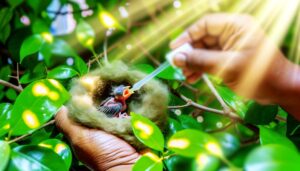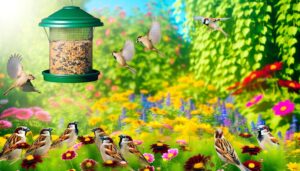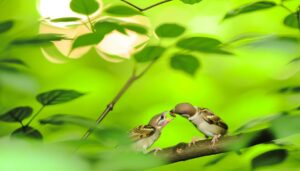How Long Do Sparrows Feed Their Young: Observing Parental Care
Sparrows feed their young vigorously from the moment they hatch until they leave the nest, covering a span of 10 to 14 days. Both parents partake in this essential role, delivering food every 15 to 20 minutes.
The diet consists primarily of insects, which are protein-rich, along with seeds and small fruits. This intensive feeding guarantees rapid growth and feather development.
As nestlings grow, their feeding demands increase, prompting more frequent nourishments. The end of the nestling stage marks a reduction in parental feeding as fledglings begin to forage independently.
Understanding this process reveals much about their developmental journey.
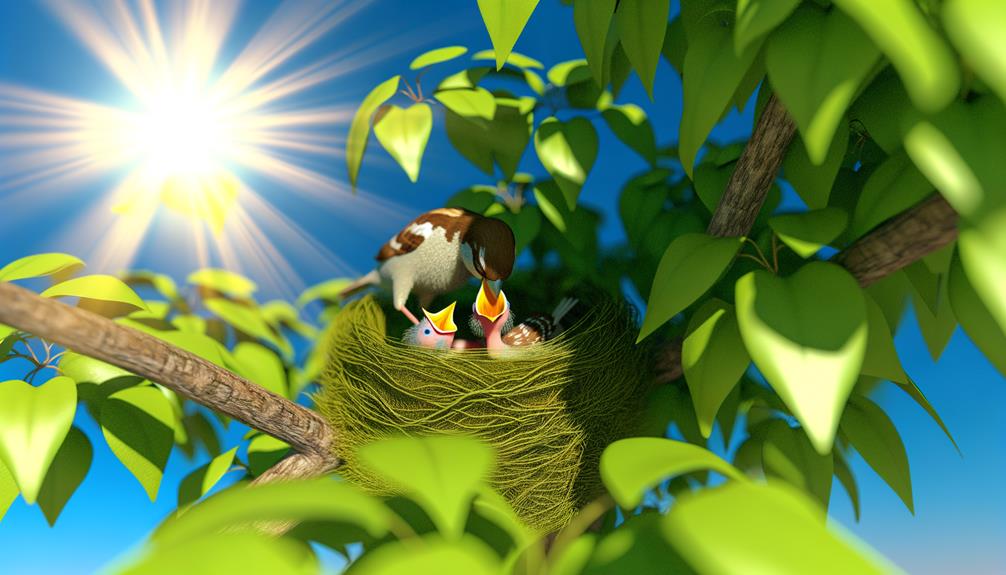
Key Takeaways
- Sparrows feed their young every 15 to 20 minutes during the nestling stage.
- The nestling stage lasts about 10 to 14 days, during which both parents feed the chicks.
- Feeding frequency is influenced by parental experience and environmental conditions.
- Parents provide a varied diet including insects, seeds, and small fruits to optimize health.
- Feeding frequency decreases as fledglings begin to forage independently after the nestling stage.
Hatching to Nestling Stage

After hatching, sparrow chicks enter the nestling stage, during which they are entirely dependent on their parents for nourishment and care. This stage is vital for the chicks' survival and development.
Nestlings are born altricial, meaning they are blind, featherless, and immobile immediately after hatching. Parental effort is paramount; both male and female sparrows participate in feeding and protecting the young. The parents engage in continuous brooding to maintain the nestlings' body temperature and shield them from potential predators.
Observational studies indicate that during this period, the chicks exhibit rapid growth and feather development. The nestling stage typically lasts about 10 to 14 days, during which the parents' relentless care ensures the chicks' progression to fledglings.
Frequency of Feeding
The frequency of feeding in sparrow nestlings is a crucial factor that greatly influences their growth and development during the early stages of life. Observational studies indicate that parent sparrows feed their young approximately every 15 to 20 minutes during daylight hours. This intensive feeding schedule ensures a constant supply of nutrients necessary for rapid growth.
Several variables can affect this frequency, including:
- Parental Experience: More experienced parents tend to feed more efficiently.
- Environmental Conditions: Weather and availability of food sources can impact feeding intervals.
- Nestling Demand: As nestlings grow, their demand for food increases, prompting more frequent feedings.
Understanding these factors provides insight into the complex dynamics of sparrow parental care and its essential role in offspring survival.
Types of Food Provided
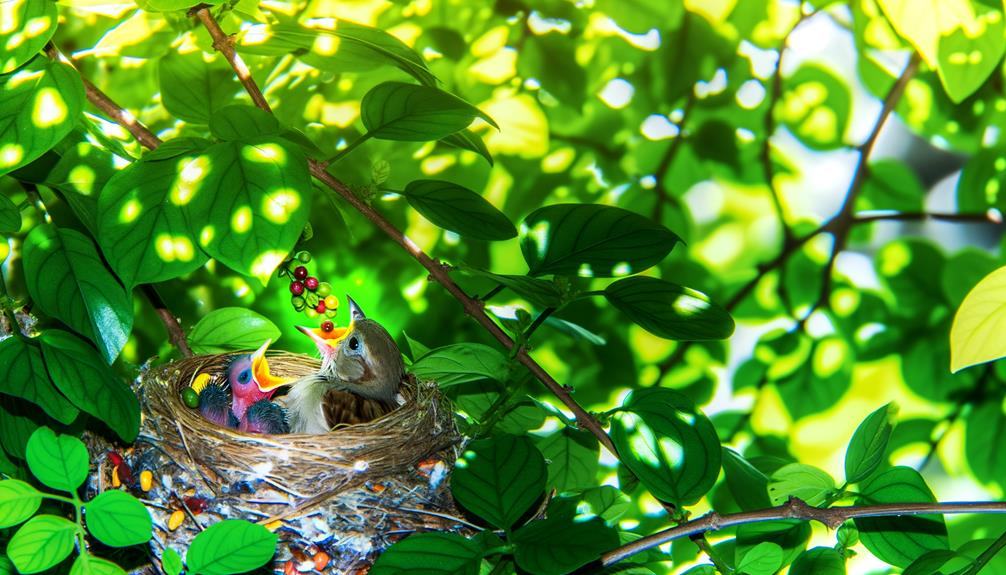
Parent sparrows provide a varied diet to their young, primarily consisting of insects, seeds, and occasionally small fruits, ensuring a balanced intake of proteins and other essential nutrients.
Insects such as caterpillars, beetles, and spiders are rich in protein, pivotal for the rapid growth and development of the fledglings. Seeds offer a source of carbohydrates and fats, supplementing the energy needs of the young birds. The inclusion of small fruits provides essential vitamins and minerals.
This dietary diversity is strategically selected by the parent sparrows to optimize the health and survival rates of their offspring. Observational studies indicate that parent sparrows meticulously forage and select food items based on the nutritional requirements of their developing young.
Growth and Development Milestones
Meticulous foraging and dietary selection by parent sparrows significantly influence the growth and development milestones of their young, ensuring they achieve key stages such as feather development, physical strength, and fledging readiness. The initial days post-hatching are vital, as the nestlings require a high-protein diet to support rapid growth.
Observational studies indicate several key milestones:
- Feather Development: Within the first week, pin feathers begin to emerge, providing essential insulation.
- Physical Strength: By day ten, the young sparrows exhibit significant muscle development, essential for future flight.
- Fledging Readiness: Around day fifteen, nestlings start showing pre-fledging behaviors, such as wing flapping.
These milestones are crucial for the young sparrows' survival and eventual independence.
Transition to Independence
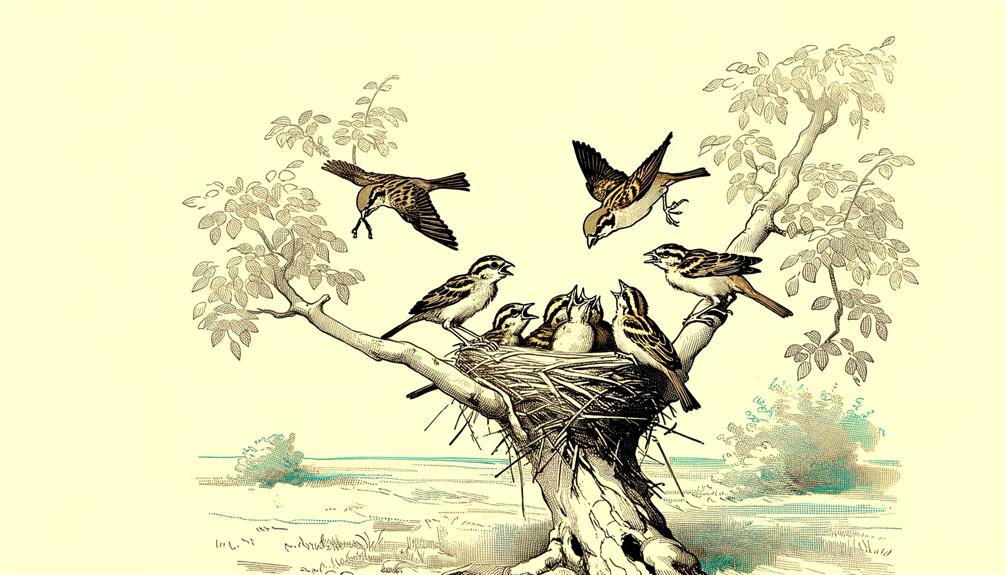
As young sparrows approach their fledging stage, they gradually increase their independence through a series of behavioral adjustments and physical developments.
During this crucial period, juvenile sparrows exhibit improved motor skills and exploratory behaviors, such as short flight attempts and foraging trials. Their plumage shifts to a more adult-like appearance, providing better insulation and aerodynamic efficiency.
Parents reduce feeding frequency, encouraging fledglings to forage independently. Social interactions also evolve, as fledglings learn to communicate effectively within the flock.
These adjustments are essential for survival, enabling young sparrows to navigate their environment, evade predators, and locate food sources. The shift to independence typically spans several weeks, culminating in the young birds' full integration into adult sparrow life.
Conclusion
The nurturing period of sparrows, extending from hatching to fledging, is akin to the intricate dance of nature's clockwork, meticulously timed and precisely executed. Observations note that adult sparrows feed their young up to 30 times per day, providing a diet rich in insects and seeds. This relentless commitment guarantees the fledglings reach critical developmental milestones, ultimately preparing them for independent survival.
As the young birds leave the nest, their gradual shift mirrors the seamless change of seasons, essential to the cycle of life.


